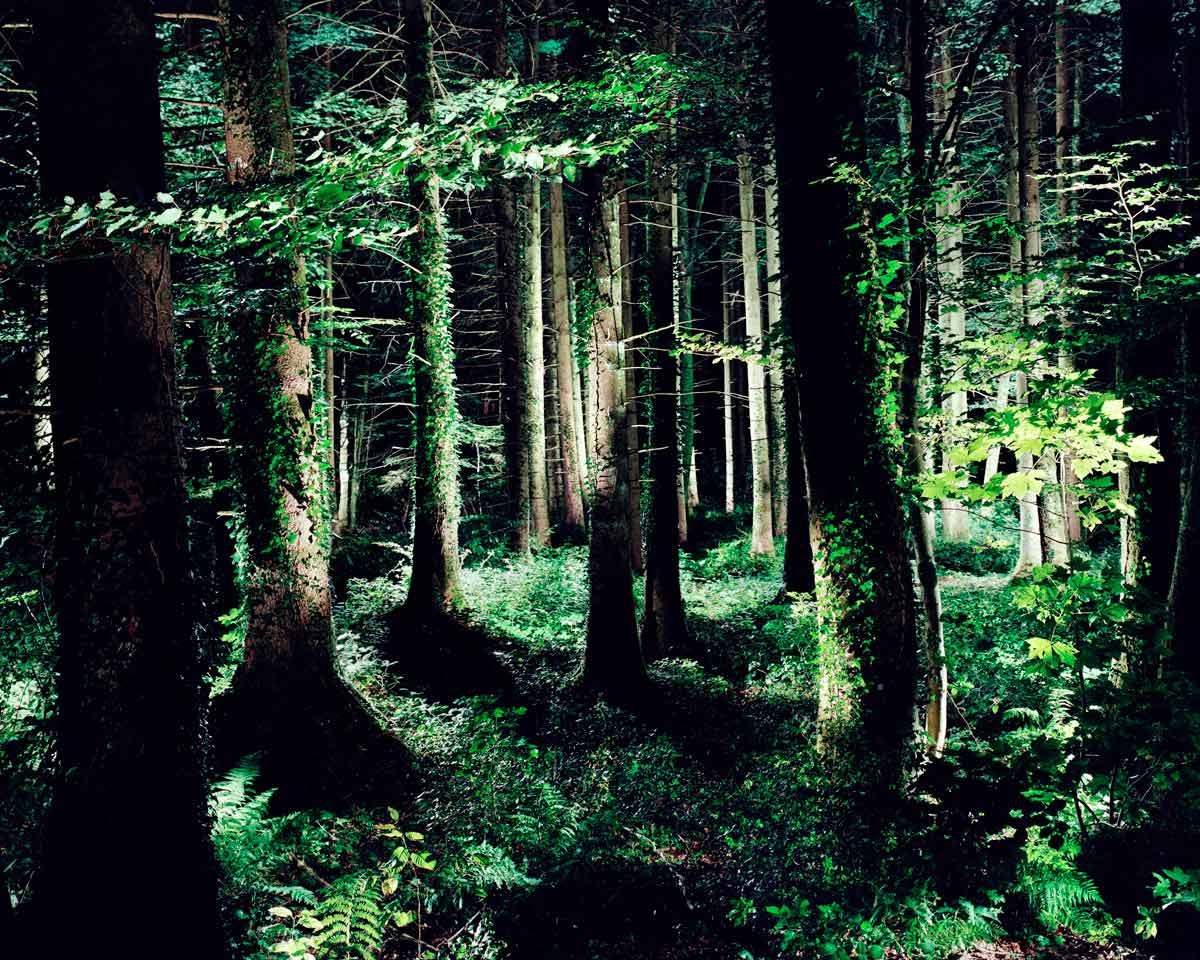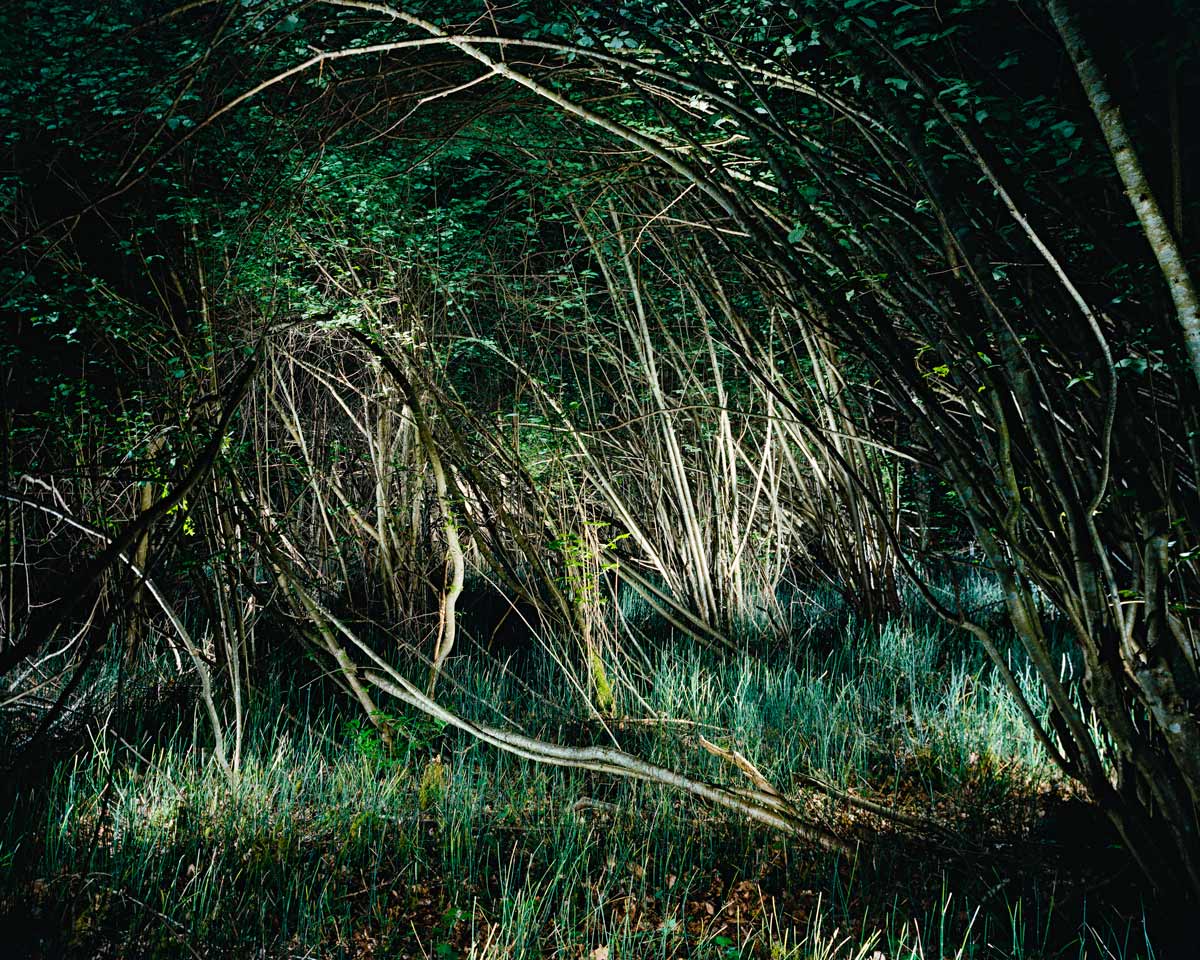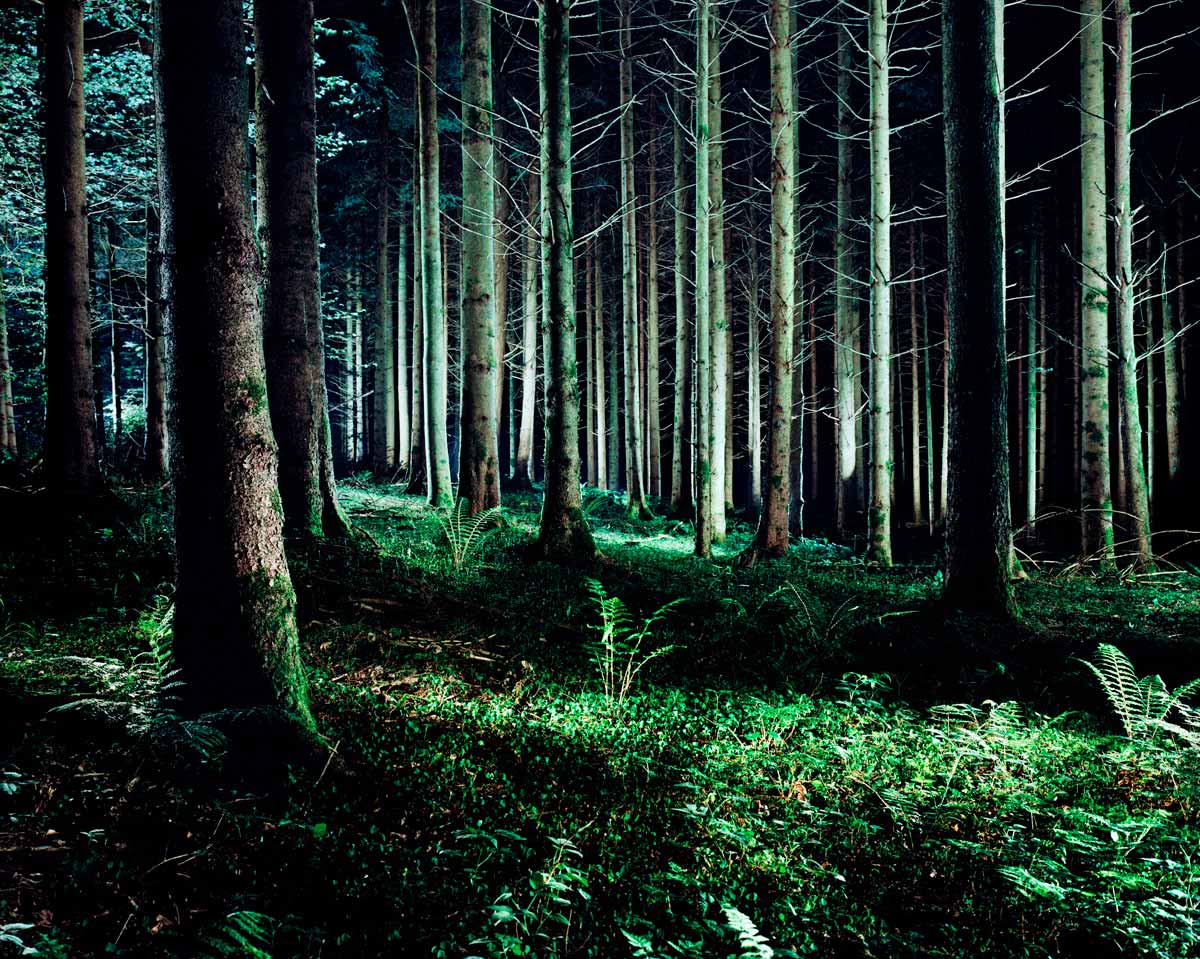I. Ein Waldstück. Ein Bildtypus, der in Malerei und Fotografie eine lange Tradition hat. Denn das Licht, das in den Wald fällt, ist von besonderer Art; es ist ein Licht im Dunkeln oder in der Dämmerung des Waldesinneren, ein Licht, das durch Stämme, Äste und Blätter zu einem reizvollen Lichtspiel wird.
Das Licht auf Andreas Gerbers Fotografien jedoch hat etwas Unwirkliches. Es sind keine Sonnenstrahlen im Waldesdunkel. Es ist auch keine von der Sonne hell beschienene Lichtung, denn dafür stehen die Bäume zu dicht und das Laubwerk ist zu geschlossen. Und ein Scheinwerfer würde den Wald und die Bäume frontaler und punktueller ausleuchten. Die Lichtquelle ist nicht ersichtlich, ist weder eruierbar noch lokalisierbar. Das Licht scheint aus dem Inneren des Bildes zu strahlen – als ob, was kaum möglich ist, faulendes Holz äusserst stark irrlichtern würde. Am ehesten ist die Wirkung, vielleicht mit der Beleuchtung eines Dioramas in einem naturhistorischen Museum zu vergleichen: plastische Lichtillusion, irritierendes Kunstlicht.
Der Blick wandert im Wald herum und heftet sich da und dort Details: leuchtende Blätter, Efeu, der sich an der Baumrinde heraufrankt, Moos, Gestrüpp, Gesträuch, Baumstämme. Der Blick verliert sich im Wald. Und wird doch gehalten durch die austarierte Bildkomposition der parallelen Vertikalen. Auf anderen Fotografien ergibt sich ein Gleichgewicht des asymmetrischen Vordergrundes, der Diagonalen, die von links unten nach rechts oben streben. Da hat, das sieht man gleich, keiner einfach in den Wald geleuchtet, und der Wald hat dann gewissermassen zurückgeleuchtet, analog zum Sprichwort: Wie man in den Wald hineinruft, so schallt es heraus. Das ist hier nicht der Fall. Und dass macht diese Fotografien so irritierend: Das innere Leuchten ist geheimnisvoll, mitsamt dem Unheimlichen, das hier mitschwingt, mitsamt dem Schauderhaften, das in Märchen erzählt wird und Hänsel und Gretel verängstigte, als sie durch den Wald irrten und nicht mehr aus noch ein wussten.
Ähnlich ergeht es dem Blick, der über die Fotografie Grebers schweift und in sie einzudringen versucht.
II. So deutlich also Grebers Fotografien in der Tradition einer Bildtypologie stehen, so sehr unterscheiden sie sich von den bekannten Waldszenerien. Das hängt mit der Art zu tun, wie der Fotograf in seinem Werk die Möglichkeiten der Fotografie auslotet. Bei ihm ist Fotografie – abgesehen von seinen Reportagen – nie blosses Abbild, sondern die Selbstreflexion des Mediums.
Um dies zu verstehen, muss die Versuchsanordnung skizziert werden, die zu Grebers Waldbildern führt. Der Fotograf wählt sich am Tag ein Waldstück aus und begeht es ausführlich; er prägt sich die Topografie ein, Strukturen und Linien. Noch entsteht kein physisches Bild, sondern erst die Vorstellung eines Bildes, die dann dazu führt, den Ort zu bestimmen, wo dann die Grossbildkamera aufgestellt wird.
In der Nacht kehrt er zurück. Das Waldstück ist mit drei rot blinkenden Fahrradlampen abgesteckt, sodass sich vom Standort der Kamera aus ein Dreieck bildet. Hinter der fix positionierten Kamera steht die Assistents. Der Fotograf selbst fotografiert also nicht im eigentlichen Sinn. Vielmehr begeht er das Waldstück systematisch und richtet das Blitzgerät auf jene Stellen, die er sich am Tag gemerkt hat. Allerdings tappt er dabei im Dunkeln, manchmal auch in eine Kuhle; der Zufall spielt mit. Bei jeder Stelle, die er erreicht und die ihm einzuleuchten scheint, schreit er den Befehl zum Auslösen. Per Funk löst die Assistents das Blitzlicht aus, die beleuchtete Stelle wird aufs Negativ gebannt. Pro Waldgang braucht es dabei nur ein Negativ; das Bild, das am Schluss vorliegt, ist eine vielfache Mehrfachbelichtung, die, obwohl für den Abzug digitalisiert, in keiner Weise nachbearbeitet wird. Der Fotograf macht also Bilder ins Dunkle, ohne dass er das Bild sieht, das Stück für Stück, Stelle für Stelle entsteht. Die Kunst oder die List besteht darin achtzugeben, dass der Fotograf selbst zwar stets im Bild ist, aber nicht ins Blitzlicht rückt. Er ist der unsichtbar anwesende Lichtbringer. Er ist es, der bestimmt, was im Licht aufleuchtet.
Wenn sonst die Fotografie das vorhandene Licht – und sei es auch das gerichtete oder das durch Blitz erzeugte – auf einmal aufzeichnet, so wird hier das Licht sozusagen addiert. Zu Recht sagt denn Greber auch, dass er die Fotografie, in der ursprünglichen Wortbedeutung: die Licht-Zeichnung, mit seiner Versuchsanordnung ausweitet. Er ist es, der durch sein Gehen und Stehen bezeichnet, was ans Licht kommt. Indem er durch den Wald geht, zeichnet er mit dem Blitzgerät das Licht ins Bild. Er zündet in den Bildern das Licht an, macht gezündete Bilder. Und das ist eine zündende Bildidee. An ihr ist das Schönste die Irritation, die das aus dem Innern der Bilder leuchtende Licht auslöst.
Konrad Tobler



